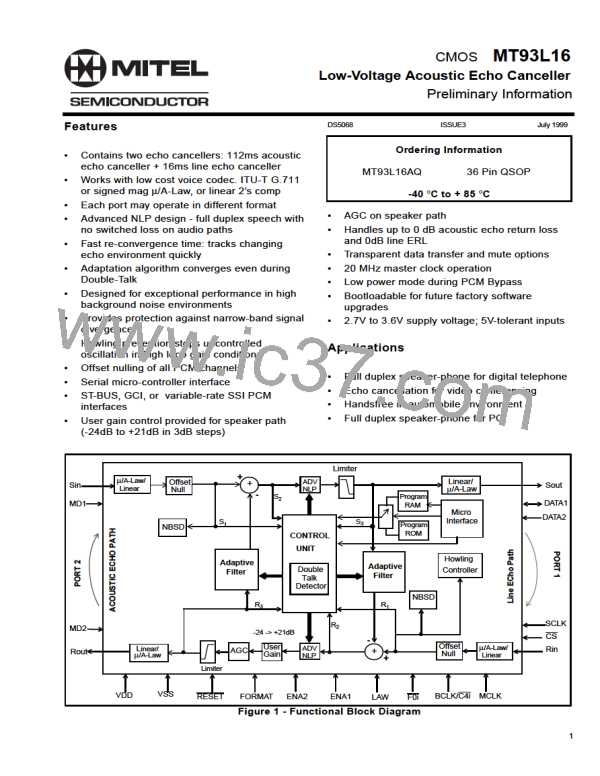MT93L16
Preliminary Information
•
•
PCM encoder/decoder compatible with µ/A-
Law ITU-T G.711, µ/A-Law Sign-Mag or linear
2’s complement coding.
Functional Description
The MT93L16 device contains two echo cancellers,
as well as the many control functions necessary to
operate the echo cancellers. One canceller is for
acoustic speaker to microphone echo, and one for
line echo cancellation. The MT93L16 provides clear
signal transmission in both audio path directions to
ensure reliable voice communication, even with low
level signals. The MT93L16 does not use variable
attenuators during double-talk or single-talk periods
of speech, as do many other acoustic echo
cancellers for speaker-phones. Instead, the
MT93L16 provides high performance full-duplex
operation similar to network echo cancellers, so that
users experience clear speech and un-interrupted
background signals during the conversation. This
prevents subjective sound quality problems
associated with “noise gating” or “noise contrasting”.
Automatic gain control on the receive speaker
path.
Adaptation Speed Control
The adaptation speed of the acoustic echo canceller
is designed to optimize the convergence speed
versus divergence caused by interfering near-end
signals. Adaptation speed algorithm takes into
account many different factors such as relative
double-talk condition, far end signal power, echo
path change, and noise levels to achieve fast
convergence.
2
Advanced Non-Linear Processor (ADV-NLP)
(2. Patent Pending)
The MT93L16 uses an advanced adaptive filter
algorithm that is double-talk stable, which means
that convergence takes place even while both parties
After echo cancellation, there is likely to be residual
echo which needs to be removed so that it will not be
audible. The MT93L16 uses an NLP to remove low
level residual echo signals which are not comprised
of background noise. The operation of the NLP
depends upon a dynamic activation threshold, as
well as a double-talk detector which disables the
NLP during double-talk periods.
1
are talking . This algorithm allows continual tracking
of changes in the echo path, regardless of double-
talk, as long as a reference signal is available for the
echo canceller.
(1. Patent Pending)
The echo tail cancellation capability of the acoustic
echo canceller has been sized appropriately (112ms)
to cancel echo in an average sized office with a
reverberation time of less than 112ms. The 16ms line
echo canceller is sufficient to ensure a high ERLE for
most line circuits.
The MT93L16 keeps the perceived noise level
constant, without the need for any variable
attenuators or gain switching that causes audible
“noise gating”. The noise level is constant and
identical to the original background noise even when
the NLP is activated.
In addition to the echo cancellers, the following
functions are supported:
For each audio path, the NLP can be disabled by
setting the NLP- bit to 1 in the LEC or AEC control
registers.
•
Control of adaptive filter convergence speed
during periods of double-talk, far end single-
talk, and near-end echo path changes.
3
Narrow Band Signal Detector (NBSD)
•
•
Control of Non-Linear Processor thresholds for
suppression of residual non-linear echo.
(3. Patent Pending)
Howling detector to identify when instability is
starting to occur, and to take action to prevent
oscillation.
Single or multi-frequency tones (e.g. DTMF, or
signalling tones) present in the reference input of an
echo canceller for a prolonged period of time may
cause the adaptive filter to diverge. The Narrow
Band Signal Detector (NBSD) is designed to prevent
this divergence by detecting single or multi-tones of
arbitrary frequency, phase, and amplitude. When
narrow band signals are detected, the filter
adaptation process is stopped but the echo canceller
continues to cancel echo.
•
•
•
•
Narrow-Band Detector for preventing adaptive
filter divergence caused by narrow-band signals
Offset Nulling filters for removal of DC
components in PCM channels.
Limiters that introduce controlled saturation
levels.
Serial controller interface compatible with
Motorola, National and Intel microcontrollers.
The NBSD can be disabled by setting the NB- bit to 1
in the MC control registers.
4

 MITEL [ MITEL NETWORKS CORPORATION ]
MITEL [ MITEL NETWORKS CORPORATION ]